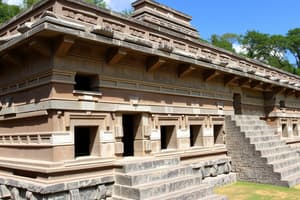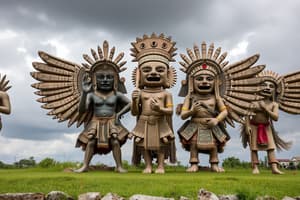Podcast
Questions and Answers
What was the role of Tezcatlipoca in Aztec religion?
What was the role of Tezcatlipoca in Aztec religion?
- The mother goddess associated with earthquakes and storms
- The god of rain
- The enigmatic trickster god (correct)
- The sun god
Which Aztec deity was associated with the night sky?
Which Aztec deity was associated with the night sky?
- Tonatiuh
- Huitzilopochtli
- Tlaloc
- Coyolxauhqui (correct)
In Aztec society, what was a common belief regarding death in battle?
In Aztec society, what was a common belief regarding death in battle?
- It led to immediate punishment.
- It was considered an act of cowardice.
- It angered the gods.
- It brought eternal life and spiritual rebirth. (correct)
Which architectural achievement is associated with the Aztecs?
Which architectural achievement is associated with the Aztecs?
What was the purpose of human sacrifice in Aztec religious ceremonies?
What was the purpose of human sacrifice in Aztec religious ceremonies?
In Aztec society, who held both political and religious power?
In Aztec society, who held both political and religious power?
What was the primary basis of the Aztec economy?
What was the primary basis of the Aztec economy?
Which recreational activity was popular among the Aztecs and involved hitting a rubber ball through stone hoops?
Which recreational activity was popular among the Aztecs and involved hitting a rubber ball through stone hoops?
What innovative engineering technique was showcased in Aztec architecture, particularly in the construction of their cities?
What innovative engineering technique was showcased in Aztec architecture, particularly in the construction of their cities?
Which group in Aztec society could own property and participate in economic activities outside the domestic sphere?
Which group in Aztec society could own property and participate in economic activities outside the domestic sphere?
Flashcards are hidden until you start studying
Study Notes
Aztec Civilization
The Aztecs were a Mesoamerican people who inhabited central Mexico from the early 14th century until the arrival of Spanish conquistadors in the early 16th century. Their capital city, Tenochtitlán, was built on an island in Lake Texcoco. This article explores the various aspects of Aztec life, including their religious beliefs, social organization, economic activities, cultural practices, and architectural achievements.
Aztec Religion
The Aztecs were polytheistic, worshipping numerous gods associated with natural phenomena and human experiences. Their pantheon included Tlaloc, the god of rain; Huitzilopochtli, the patron deity of the Mexicas; Tezcatlipoca, the enigmatic trickster god; Tonatiuh, the sun god; Coyolxauhqui, a goddess of the night sky; and Coatlicue, a mother goddess associated with earthquakes and storms. The Aztecs also had a complex cosmovision, which divided the universe into five levels called "sky-terrains," each corresponding to different realms of existence.
Religious ceremonies played a vital role in daily Aztec life. These events often involved human sacrifice, primarily of captive warriors, as a means of appeasing their gods and ensuring continued prosperity. Some scholars argue that this practice may have been more symbolic than truly necessary for sustaining the community. The Aztecs believed that death in battle brought eternal life and spiritual rebirth.
Aztec Society
Social structure in Aztec society was hierarchical, based on both birth and merit. At the top were the rulers, who held both political and religious power. Below them were nobles, commoners, and slaves. Nobles were expected to contribute to public works projects and hold high positions within society, while commoners engaged in agriculture and other labor-intensive tasks. Slaves were usually prisoners of war, debtors, or children born out of wedlock.
Women in Aztec society had significant roles in religious and communal affairs. They could own property and participate in economic activities outside the domestic sphere. However, they generally held lower status compared to men, as indicated by their exclusion from certain public rituals and speeches.
Aztec Economy
The basis of the Aztec economy was agriculture, particularly maize cultivation. Farming was done under a system known as chinampas, where fields were constructed on lakebeds using organic matter. Other crops included beans, squash, avocados, tomatoes, and chili peppers. Agriculture was supplemented by hunting, gathering, fishing, and trading.
Markets were important centers of trade in Aztec society. Goods exchanged included foodstuffs like corn, beans, and tobacco; textiles made from cotton and maguey fibers; precious stones; and metalwork. There is evidence that some markets functioned as cooperatives, where merchants pooled resources and shared profits.
Aztec Culture
Ball games were popular recreational activities among the Aztecs. One such game, called "pok-a-tok" or "ulama," involved two teams trying to hit a rubber ball through stone hoops. Music and dance were integral parts of Aztec culture, and these art forms were used during festivals, funerals, and other occasions.
The Aztecs were renowned for their artistic skills, evidenced by their elaborate murals, sculptures, pottery, and metalwork. Their writing system, carved onto bark paper or bone tablets, combined pictures of objects with symbols representing numbers.
Aztec Architecture
Aztec architecture showcased innovative engineering techniques, particularly in the construction of their cities. For example, Tenochtitlán was built on an artificial foundation consisting of interlocking logs set in mud. Buildings were typically composed of wood, adobe, or stone, with roofs covered in grass, palm leaves, or cactus fiber mats.
Temples and pyramids were major architectural features in Aztec cities. Many of these structures incorporated astronomical observations and served multiple functions, including housing marketplaces, libraries, and schools. In addition, the Aztecs employed hydraulic engineering to create aqueducts, canals, and reservoirs, providing water for agricultural purposes and urban life.
Studying That Suits You
Use AI to generate personalized quizzes and flashcards to suit your learning preferences.




